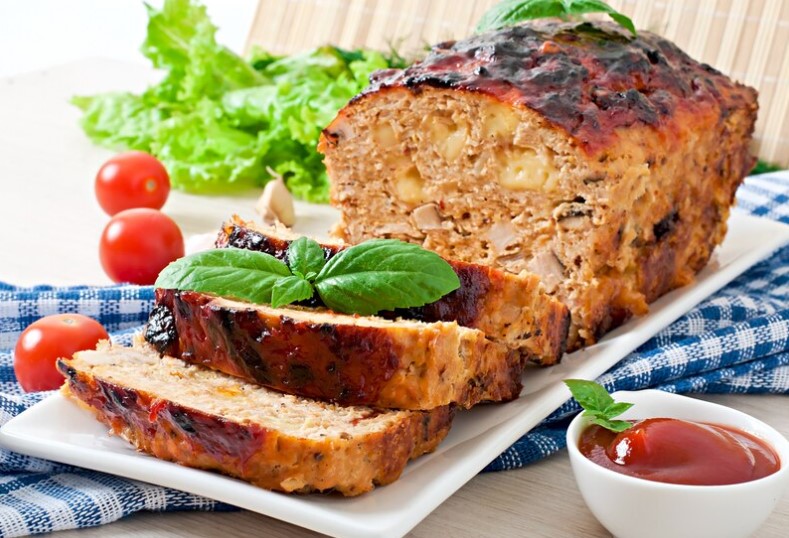11 Secrets to an Unforgettable, Easy-Pleasing Meatloaf
Introduction: The Allure of Easy-Pleasing Meatloaf
This Easy Meatloaf Recipe is a go-to for a quick, satisfying family dinner. A timeless classic in many households, it has evolved into a dish that not only satisfies hunger but also brings a sense of comfort and nostalgia. The easy, pleasing meatloaf, in particular, stands out for its simplicity and universal appeal. This article delves into the secrets of creating a meatloaf that is both easy to make and a joy to eat, ensuring that every bite is a delightful experience.
Ingredients and Quantities for Classic Meatloaf with Substitutions
Meatloaf is a versatile dish that can be cooked using various methods, each bringing out different flavors and textures. Here are some common cooking methods:
1. Oven Baking
- Traditional Approach: The most common way to cook meatloaf is by baking it in the oven. This method provides a consistent heat that cooks the meatloaf evenly.
- Temperature and Time: Typically baked at 350°F (175°C) for about 1 hour, depending on the size and shape of the loaf.
- Benefits: Oven baking allows for a crispy exterior and a moist interior, especially when a glaze is applied.
2. Slow Cooking
- For Tenderness: Using a slow cooker can result in an exceptionally tender meatloaf.
- Low and Slow: Cook on low for 6–8 hours or on high for 3–4 hours.
- Moisture Retention: The slow cooker traps moisture, ensuring the meatloaf doesn’t dry out.
3. Grilling
- Outdoor Flavor: Grilling meatloaf adds a smoky flavor that can’t be achieved in an oven.
- Indirect Heat: Use indirect heat to avoid burning. Grill for about 1 hour, similar to oven baking.
- Glaze at the End: Apply the glaze towards the end of grilling to prevent burning.
4. Smoking
- Smoky Aroma: Smoking meatloaf infuses it with a deep, smoky flavor.
- Longer Cooking Time: It takes longer than traditional baking, often several hours, at a lower temperature.
- Wood Choices: Different types of wood chips can be used to vary the flavor.
5. Pan Frying (Mini Meatloaves)
- Quick Cooking: For faster cooking, form the meat mixture into smaller patties and pan-fry them.
- Even Browning: Cook over medium heat, turning occasionally for even browning.
- Time-saving: This method is much quicker than baking a whole loaf.
6. Pressure Cooking
- Fast and Moist: Using a pressure cooker can significantly reduce cooking time while retaining moisture.
- Cooking Time: It generally takes about 25–30 minutes under high pressure.
- Use a Trivet: Place the meatloaf on a trivet to prevent it from sitting in the liquid, which can make the bottom soggy.
Each method offers a unique twist to the traditional meatloaf, allowing you to experiment and find your preferred cooking style. Remember to always ensure that the meatloaf reaches an internal temperature of 160°F (71°C) for safe consumption.
Nutritional Information
Storage and Reheating Tips for Meatloaf
Proper storage and reheating are key to enjoying leftover meatloaf while ensuring it remains delicious and safe to eat.
Storage Tips
- Cooling Down: Allow the meatloaf to cool to room temperature before storing. However, don’t leave it out for more than 2 hours to avoid bacterial growth.
- Refrigeration:
- Place the meatloaf in an airtight container or wrap it tightly in plastic wrap or aluminum foil.
- Store in the refrigerator for up to 3–4 days.
- Freezing:
- For longer storage, meatloaf can be frozen. Wrap it tightly in freezer-safe wrap or place it in a freezer bag.
- It can be stored in the freezer for up to 3 months.
- Label the meatloaf with the date before freezing.
Reheating Tips
- Oven Reheating:
- Preheat your oven to 350°F (175°C).
- Place the meatloaf in an oven-safe dish and add a splash of water or broth to keep it moist.
- Cover with foil and heat for about 20–30 minutes, or until heated through.
- Microwave Reheating:
- For a quick option, reheat slices in the microwave.
- Cover with a microwave-safe lid or wrap to prevent drying out.
- Heat on medium power for 1-2 minutes, checking periodically.
- Stovetop Reheating:
- Slice the meatloaf and reheat it in a skillet over medium heat.
- Add a little oil or butter to prevent sticking and to add moisture.
- Flip the slices halfway through to ensure even heating.
Safety Considerations
- Temperature Check: When reheating, ensure the meatloaf reaches an internal temperature of 165°F (74°C) to ensure it’s safe to eat.
- Avoid Repeated Reheating: Try to reheat only the amount you plan to eat. Repeatedly reheating and cooling can increase the risk of foodborne illness.
Serving After Reheating
- Refresh the Flavor: Consider adding a fresh glaze or sauce after reheating to rejuvenate the flavor.
- Check Moisture: If the meatloaf seems dry, adding a sauce or gravy can help restore moisture.
FAQs about Meatloaf
1. How Can I Keep My Meatloaf from Falling Apart?
- Answer: Ensure you have enough binding agents, like eggs and breadcrumbs. Also, don’t overmix the meat, as this can make the texture too dense and prone to crumbling.
2. Why Is My Meatloaf Too Dry?
- Answer: Dry meatloaf often results from using meat that’s too lean, overcooking, or not including enough moist ingredients like soaked breadcrumbs, eggs, or vegetables like onions and bell peppers.
3. Can meatloaf be made ahead of time?
- Answer: Yes, you can prepare meatloaf in advance and store it in the refrigerator for up to 24 hours before baking. This can actually help the flavors meld together.
4. What’s the Best Way to Reheat Leftover Meatloaf?
- Answer: Reheat slices in the oven at 350°F (175°C) covered with foil or in the microwave covered with a microwave-safe lid. Add a splash of water or broth to keep it moist.
5. How Do I Know When My Meatloaf Is Done?
- Answer: The best way to check is by using a meat thermometer. The internal temperature should reach 160°F (71°C). The meatloaf should also be firm to the touch, and the juices should run clear.
read more
- Nutritional Information: Link to a reputable site like the USDA’s FoodData Central for detailed nutritional information about the ingredients used in the meatloaf recipe.
- Cooking Tips: Provide a link to a culinary resource like Serious Eats for readers who want to learn more advanced cooking techniques or variations.
- Side Dish Recipes: Offer a link to a popular cooking website like Allrecipes for readers looking for side dish ideas that go well with meatloaf.
- Food Safety Guidelines: Connect to a government resource like FoodSafety.gov to educate readers about safe meat handling and cooking practices.

